|
Subscribe / Renew |
|
|
Contact Us |
|
| ► Subscribe to our Free Weekly Newsletter | |
| home | Welcome, sign in or click here to subscribe. | login |
Construction
| |
October 2, 2002
Breaking out of the box, Northwest style
Special to the Journal
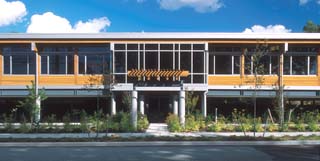
Photos by Pro Image Photo With elements such as warm wood and exposed steel, the Kessel Building grabs the eye along a busy thoroughfare. |
In good design, there’s almost always an element of surprise. But it doesn’t have to be a profound statement or stagy performance to get a second look.
In the case of the Kessel Building in Kirkland, it may just be the recognition of something honest, clearly thought out and carefully executed.
The small office building faces the north-south thoroughfare of Houghton, a neighborhood in east Kirkland. The site meshes with a neighborhood of single-family homes, but there are larger commercial sites across the street. A linear facade one story above the street announces a classic modernist box-on-legs design strategy.
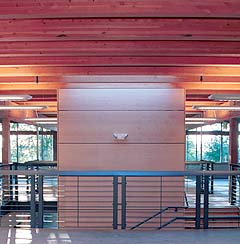
At the top of the entry stairway, views open up from all directions. |
But this one is distinguished by a fine ribbing of warm wood and exposed steel structural elements. Up close, heavy glu-lam beams and columns are visible inside the long bank of windows. The whole composition, designed by Baylis Architects, rests on concrete columns and hovers over parking. It is rigorously symmetrical, centered by an entry and stairway that also marks the core services.
In addition to an inspired architect, a good design project generally requires a special client -- one who brings a certain vision to the project but does not have a preconceived look in mind -- according to architect Thomas Frye of Baylis Architects. The firm has designed many multi-family buildings on the Eastside, but the design of the Kessel Building was a fresh experience.
| Kessel Building 600 Sixth St. S., Kirkland |
|
Architect:
Baylis Architects Developer: JDL Enterprises Project owner: JRTWO Completion date: September, 2001 Construction type: Concrete columns with steel floor system, concrete pan deck, glu-lam column and beams Building size: 15,300 square feet Construction cost: $2.4 million Structural/civil engineer: Coughlin Porter Lundeen Surveyor: Jim Hart & Associates Landscape Architect: Jongejan Gerrard McNeal Geotechnical engineer: Geotech Engineers Mechanical design/build contractor: Encompass General contractor: Chinn Construction Wiestner Wood Structures (wood structure); Northshore Sheetmetal (metal fabricator) Jury comments: This project is common -- the small office building with parking underneath. But it is not common in that it is very well designed, sensitive to its residential presence while not trying to be so contextual that it ceases to recognize itself. The forms, proportion, visual composition and especially the care in details are spiritual kin to some of the early Northwest regional work of Paul Kirk. The technology and materials of the building are current and designed so well -- a quality project. What really distinguishes this entry is the strong, well modulated facade and close attention to detail. The building successfully invokes a Northwestern feel despite a box footprint and contemporary materials. |
"When you’re working with the user, you’re obviously taking a different approach," said Frye. The building -- not just the concept, but all the nuts and bolts, inside and out -- becomes an expression of the business or occupant, he added. For design of the Kessel Building, the client was software developer Todd Turner.
Exposed ceilings, natural light and openable windows were all on Turner’s agenda. Getting daylight into the back of the building was very important for the sake of his employees. "These are people who sit at machines all day long," he said. He might have been referring to almost any office.
But his firm and a companion company had very urgent needs of their own. Both develop programs for calibrating measurement and test equipment, and occupied two houses on the site. Since all of the corners and closets in the buildings were full of wires, screens and people -- and rapid growth was projected -- developing the site to create expanded office space was in order. It was from the two software companies, which were working together constantly, that Baylis Architects took the inspiration for the "twin," or symmetrical plan of the building.
The building gets its shape directly from the program and from the constraints of the zoning code. The area is zoned for single-family residences and professional offices. Charged with maximizing the square footage of the building, accommodating 50 stalls of parking and staying under strict height limits, the design team first considered underground parking. "A million-dollar hole," said Turner.
The decision to build over the parking lot was driven by a desire to bring the front facade as close to the street edge as possible. To keep the office building under the height limit yet allow for parking underneath and high-ceiling office floor, the grade has been lowered by several feet by cutting into the hillside behind the building. Views from the residential properties behind are preserved. In front, the plan wraps around a small entry courtyard. A single stair and elevator serves pedestrians and parking, and ties the office floor to the ground and the walkway.
The winning personality of the Kessell building is built upon bold, exposed structural elements and finely calibrated details. In begins with textured concrete "sonotube" poured-in-place columns at the parking level. They hold up exposed steel I-beams, which in turn hold a steel-framed, concrete floor. Above that, the roof is supported by heavy, glu-lam columns and beams.
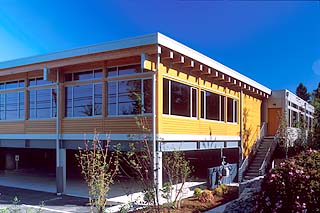
The grade was lowered several feet by cutting into the hillside behind the building. |
All of these design elements help to answer a question originally posed by project architect Ed Sozinho: How do you build it on legs -- without making it a woody walk-up?
Although the building is clad in wood, it is anything but "woody." Instead, a carefully calibrated system of wood siding -- with a glowing, warm finish -- complements the simple, strong geometry and steel structure of the building. Underneath, it is sided with cement board, painted black. The horizontal wood pieces -- a farm-raised wood used as stock door jamb material -- was milled to fit the specifications. Each piece was back-routed to prevent curvature and pre-stained on site before being bolted onto the background.
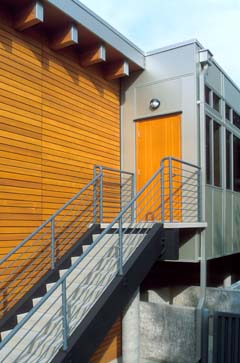
Contrasting exterior finishes meet at side entrances. |
Because of the proximity of the back of the building to the property line, it was necessary to upgrade the construction type to suit fire code. While the back and part of the sides are clad in metal, ample windows and careful detailing bring the rear half into phase with the street smarts of the Kessel Building. Metal siding also covers a center bay, with full-height windows, that projects slightly over the entry court.
Inside, between the two sides of the "twin" office floor, the central space can be maintained as a common area or divided to provide separate offices or meeting areas for each. The sealed, unfinished columns, beams, purlins and high plywood ceiling warmly reflect the western sun. Views of Lake Washington sparkle outside the tall windows. The naturally finished frames and mullions are fitted and joined with care.
As luck would have it, new owners and tenants will benefit from the design of the Kessel Building. The technology bust caught up with the original clients. In 1999, Todd Turner and his partners sought a developer to take over the project so that it could begin construction.
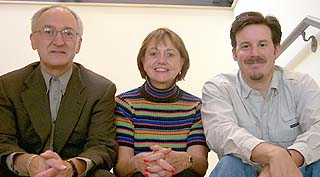
Photo by Clair Enlow Thomas Frye of Baylis Architects, Marian Kessel of JDL Enterprises and Ed Sozinho of Baylis Architects |
They found one in JDL Enterprises. Namesake Marian Kessel kept the concept and execution of the design intact in her management position with JDL. General contractor Chinn Construction brought its own commitment and creativity to the project.
And now, the story of the "book-matched" Kessel Building is about to begin. The new tenant is Technical Glass Products, maker of the glass "cauldron" that held the torch in the last Winter Olympics. According to COO Fred Baruch, who will move from Carillon Point, the choice of the new building was easy. The company will keep the open feeling of the office.
"It perfectly captures the spirit of the Pacific Northwest," he said.
Clair Enlow can be reached by e-mail at clair@clairenlow.com.
Previous columns:
- At BCC, a study in sustainable design, 09-04-2002
- A retreat for teens ends decade-long run-around, 08-07-2002
- A once lackluster hall now scans the heavens, 07-03-2002
- Design team got a workout at Hec Ed, 06-05-2002
- A terra cotta shell for intimate dining, 05-01-2002
- Serious, modern City Hall, with a friendly barn door, 04-03-2002
- Tiny Mercer Island chapel solves a small, tricky problem, 03-06-2002
- Temporary library makes a lasting impression, 02-06-2002


